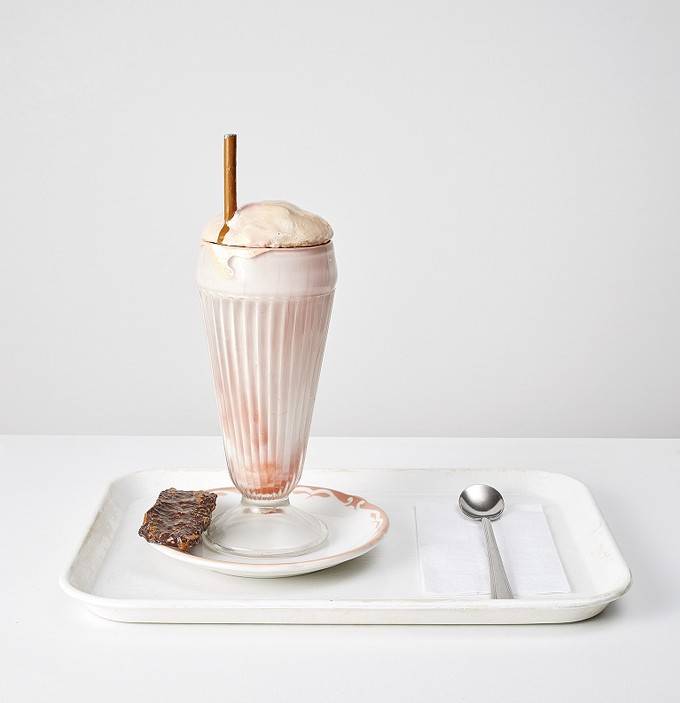
Image: Ice Cream Soda with Cookie (1963) by Claes Oldenburg.
Students reimagine the soft sculptures of late pop art heavyweight Claes Oldenburg
Graduate students at OCAD University are helping to ensure the legacy of Swedish-born American pop artist Claes Oldenburg, who passed away at the age of 93 in July, lives on, by giving viewers new ways to experience his soft sculptural work through the senses, beyond the visual.
In May, Contemporary Art, Design and New Media alum Kyrie Robinson and Inclusive Design graduate student Parth Shah transformed Oldenburg’s delightful Ice Cream Soda with Cookie (1963) sculpture through sound, as part of the Inclusive Design Multisensory Museum class taught at OCAD U.
Organized in partnership with the Art Gallery of Ontario (AGO), students enrolled in the unique course consider how artists, designers, galleries and museums can create inclusive art experiences for audiences with diverse accessibility needs. Students, including Robinson and Shah, reimagine canonical visual artworks from the museum’s collection for visitors with disabilities and various forms of human difference using a range of high- and low-tech approaches including 3D printing, music composition, fragrance and even taste.
Since the course was first offered in 2018, artworks and cultural objects, ranging from traditional landscape paintings, works of abstract expressionism, architectural features of the AGO itself and pop art sculptures have been re-presented by students using aural, tactile and olfactory perception methodologies facilitating a more inclusive gallery experience for all visitors.
Through audio interviews and immersive sound experiences, Robinson and Shah offered alternative perspectives of Oldenburg’s cheerful pop art piece. Their project culminated as a video presentation that was shared online as part of the AGO’s Multisensory Moments series, just two months before Oldenburg’s passing on July 18, 2022.
Shah and Robinson produced an audio description of the sculpture’s unique visual and tactile features, observing the tension created by its delicious appearance and frustrating inedibility. They also interviewed community consultants of varying ages (11 to 93) and professions (including an environmental designer and a medical doctor), recording their initial reactions to the artwork.
The direct engagement of audience members or constituents for which a project such as this seeks to benefit is the foundation of co-design, a principle that is central to the Inclusive Design graduate program that the course is a part of.
“The artwork brought up a lot of fond memories for people,” Parth notes in the project’s final presentation.
“It was fascinating to see how this artwork transported people to the same place regardless of their age, gender, language, geographic location or culture,” Robinson adds.
The multisensory translation also includes a soundscape Shah and Robinson have composed, capturing an imaginary diner, where the objects Ice Cream Soda with Cookie is composed of might be found. Sounds of clanking glasses, a waitress taking orders, a song playing from a jukebox in a distant corner, all capture the retro restaurant environment, transporting the listener to Oldenburg’s original place of inspiration.
The AGO has a storied history collecting the pop artist's works, having acquired one of his most renowned pieces Floor Burger (1962) in 1967 for $2,000 (CAD). The sculpture, made of canvas filled with foam rubber and cardboard boxes, painted with acrylic paint, was met with controversy when it was first added to the museum’s holdings and gained renewed attention in 2012 when its restoration by AGO conservator Sherry Phillips was put on public display outside the Henry Moore Sculpture Centre on the museum’s second floor. Phillips carried out her preservation work in the open air of the gallery for visitors to observe and learn from.
Multisensory objects created as part of the Multisensory Museum course often join the AGO’s tactile tours, which are led by Melissa Smith, Assistant Curator of Access and Learning at the museum. Smith, who was part of the development of the Multisensory Museum course along with former Inclusive Design Graduate Program Director and current Associate Professor in the Faculty of Design at OCAD U, Dr. Peter Coppin, is now its primary instructor. Dr. Coppin and Smith discussed the course virtually in January, sharing with the community the course's creation and impacts.